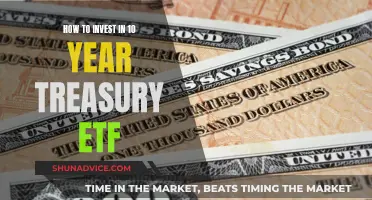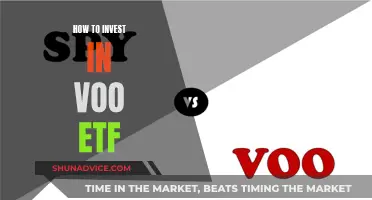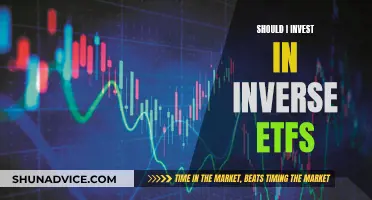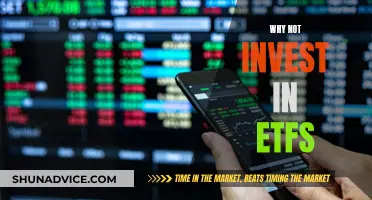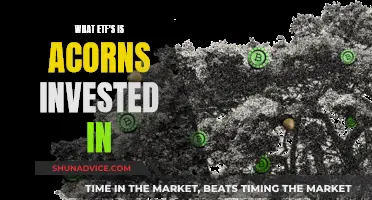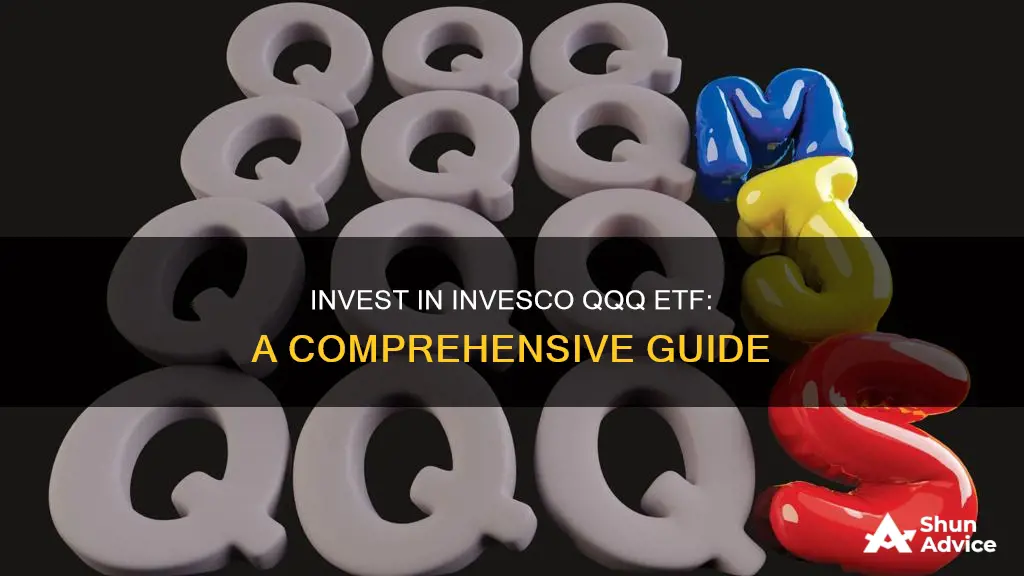
The Invesco QQQ is an exchange-traded fund that tracks the Nasdaq-100 Index, which consists of the 100 largest US and international non-financial companies listed on the Nasdaq Stock Market based on market capitalisation. The fund's investment objective is to provide investment results that generally correspond to the price and yield performance of the Nasdaq-100 Index. The Invesco QQQ ETF has outperformed the S&P 500 over the past decade, with an average annual return of 20.27% versus 14.26%. It also offers a dividend yield of 0.48% and is the second most frequently traded ETF in the US.
What You'll Learn
- Direct investment: Open an International Trading Account and add funds in US dollars
- Indirect investment: Invest in mutual funds and ETFs that offer exposure to global stocks
- Dividend yield: The ETF has a 0.48% dividend yield
- Liquidity: The ETF is the second most frequently traded in the US
- Expense ratio: The fund has a relatively high expense ratio of 0.20%

Direct investment: Open an International Trading Account and add funds in US dollars
To invest in the Invesco QQQ ETF, you can choose to open an International Trading Account and add funds in US dollars. Here's a step-by-step guide on how to do this:
- Choose a Brokerage Firm: Select a reputable brokerage firm that offers international trading accounts. Research their fees, services, and features to find one that aligns with your investment goals and needs.
- Open an International Trading Account: Visit the website of your chosen brokerage firm and sign up for an international trading account. You will need to provide personal information and sign up. You may also need to set up a user profile and create a password.
- Fund Your Account: To start investing in the Invesco QQQ ETF, you will need to deposit funds into your international trading account. Ensure that you have sufficient funds in US dollars, as the Invesco QQQ ETF is listed on the NASDAQ and trades in US dollars. You can link your bank account or transfer funds from another trading account to fund your new international trading account.
- Search for the Invesco QQQ ETF: Once your account is funded, you can search for the Invesco QQQ ETF by its ticker symbol, QQQ. This will allow you to find the fund and review its performance, holdings, and other relevant information.
- Place Your Order: After reviewing the details of the Invesco QQQ ETF, you can place your buy order through your brokerage account. Specify the number of shares you wish to purchase, and your order will be executed at the current market price.
- Monitor and Manage Your Investment: Regularly review the performance of your investment in the Invesco QQQ ETF. You can track its price movements, follow news related to the fund, and assess its overall performance over time. Depending on your investment strategy, you may choose to buy more shares or sell a portion of your holdings.
Remember that investing in any financial product involves risk, and the value of your investment can go up or down. Always conduct thorough research and consider seeking independent financial advice before making any investment decisions.
ETF Creators: Smart Investment Strategies for Beginners
You may want to see also

Indirect investment: Invest in mutual funds and ETFs that offer exposure to global stocks
Exchange-traded funds (ETFs) are a type of index fund that can be traded like an individual stock on an exchange. They are a collection of securities that can be bought and sold on a stock exchange at any time during trading hours.
ETFs are a great way to gain exposure to global stocks indirectly. They are a low-cost investment option that allows investors to take exposure to several stocks of the same index at one time. They are also a great way to diversify your portfolio, as they can span multiple asset classes, sectors, and industries.
- Open a brokerage account: You will need a brokerage account to buy and sell securities like ETFs. Many brokerages have no account minimums, transaction fees, or inactivity fees.
- Find and compare ETFs: Use screening tools provided by brokers to narrow down the thousands of ETFs available based on criteria such as asset type, geography, industry, trading performance, or fund provider.
- Buy the ETF: Navigate to the "trading" section of your brokerage's website and purchase the ETF using its ticker symbol.
- Relax: Congratulations! You've just bought your first ETF. These funds can help form the basis of a well-diversified portfolio.
Some popular ETFs that offer exposure to global stocks include:
- SPDR S&P 500 (SPY): Tracks the S&P 500 Index.
- IShares Russell 2000 (IWM): Tracks the Russell 2000 small-cap index.
- Invesco QQQ (QQQ): Tracks the Nasdaq 100 Index, which includes stocks of innovative companies like Apple, Microsoft, Amazon, and Facebook.
- SPDR Dow Jones Industrial Average (DIA): Represents the 30 stocks of the Dow Jones Industrial Average.
ETFs are a great option for those looking for indirect investment in global stocks due to their low costs, diversification benefits, and ease of trading.
Carbon Credits ETF: A Smart Investment Strategy
You may want to see also

Dividend yield: The ETF has a 0.48% dividend yield
Dividends are a powerful source of income for investors. Dividend-focused ETFs can be a great way to increase cash flow and diversify investments.
Dividend yield refers to how much a company pays out in dividends each year relative to its share price. It is usually expressed as a percentage. For example, if a company's annual dividend payment is $4 and the share price is $100, the dividend yield would be 4%.
The Invesco QQQ ETF has a dividend yield of 0.48%. This means that, over a year, shareholders could expect a 0.48% return on their shares in the form of dividend payments.
Compared to other ETFs, a dividend yield of 0.48% is relatively low. For example, the Invesco KBW Premium Yield Equity REIT ETF has a dividend yield of 11.24%, and the Invesco S&P Ultra Dividend Revenue ETF has a dividend yield of 3.15%.
It's important to note that a high dividend yield doesn't always indicate a strong investment opportunity. Sometimes, a very high yield can be a sign that a company will cut its dividend payment in the future. Additionally, it's crucial to consider other factors when evaluating an ETF, such as the fund's performance, expense ratio, and asset allocation.
When investing in dividend ETFs, it's essential to have a solid understanding of your financial goals, conduct thorough research, outline your asset mix, and regularly review your investments.
ETFs for Tech: Direct Investment Strategies
You may want to see also

Liquidity: The ETF is the second most frequently traded in the US
The Invesco QQQ ETF is one of the most actively traded securities, with a history dating back to its inception in 1999. It is the second most frequently traded ETF in the US, based on average daily volume traded, as of 30 September 2024.
The liquidity of an ETF is influenced by more factors than just its trading volume. The liquidity of the underlying holdings is often a better predictor of an ETF's liquidity. For instance, an ETF with relatively low trading volume but with investments in highly liquid large-cap US stocks will generally have high liquidity and low bid-ask spreads.
Invesco QQQ is highly liquid as it is one of the most actively traded securities and it has a long trading history. It is also a passively managed ETF, meaning that it tracks an index. In this case, it is the Nasdaq-100 index, which includes many of the world's leading technology and innovative companies.
Invest in Bharat 22 ETF: A Guide to Getting Started
You may want to see also

Expense ratio: The fund has a relatively high expense ratio of 0.20%
The Invesco QQQ Trust (QQQ) is an exchange-traded fund (ETF) that gives you access to Nasdaq 100 companies in a single investment. It is rated among the top 1% of best-performing large-cap growth funds based on total return over the past 15 years.
Expense Ratio
The expense ratio of a fund or ETF is an important consideration for investors, as it lets them know how much they pay to invest in a specific fund and how much their returns will be reduced. The expense ratio is calculated by dividing a fund's net expenses by its net assets. The lower the expense ratio, the better, as this means that an investor receives higher returns on their invested capital.
The Invesco QQQ ETF has a relatively high expense ratio of 0.20% (or 0.38% according to another source). This is significantly higher than the lowest-cost ETFs, which tend to have expense ratios of less than 0.10%. However, it is still lower than the highest-cost ETFs, which can have expense ratios exceeding 10%.
The expense ratio of the Invesco QQQ ETF covers various costs, including management, marketing, and distribution fees, as well as fees for accounting, administration, record-keeping, custodial services, and legal services.
While the expense ratio may seem like a small percentage, even small ratios can add up over time. For example, a 0.5% expense ratio on a $100,000 investment generating 4% annual returns over 20 years could result in $20,000 lower returns.
Therefore, when considering investing in the Invesco QQQ ETF, it is important to factor in the relatively high expense ratio and how it may impact your returns over time.
Schwab's Auto-Invest Feature: A Smart ETF Strategy?
You may want to see also
Frequently asked questions
You can buy Invesco QQQ ETF shares directly or indirectly. To buy them directly, you need to open an international trading account and add funds in US dollars. To buy them indirectly, you can invest through mutual funds and exchange-traded funds (ETFs) that offer exposure to global stocks.
As of December 3, 2024, Invesco QQQ ETF shares are priced at $513.95.
Yes, you can buy fractional shares of Invesco QQQ ETF.


